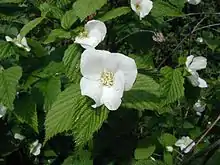| Rhodotypos | |
|---|---|
 | |
| Scientific classification | |
| Kingdom: | Plantae |
| Clade: | Tracheophytes |
| Clade: | Angiosperms |
| Clade: | Eudicots |
| Clade: | Rosids |
| Order: | Rosales |
| Family: | Rosaceae |
| Subfamily: | Amygdaloideae |
| Tribe: | Kerrieae |
| Genus: | Rhodotypos Siebold & Zucc. |
| Species: | R. scandens |
| Binomial name | |
| Rhodotypos scandens | |
Rhodotypos scandens, the sole species of the genus Rhodotypos, is a deciduous shrub in the family Rosaceae, closely related to Kerria and included in that genus by some botanists. It is native to China, Korea, possibly also Japan.
Description


It grows to 2–5 m tall, with (unusually for a species in the Rosaceae) opposite (not alternate) leaves, simple ovate-acute, 3–6 cm long and 2–4 cm broad with a serrated margin. The flowers are white, 3–4 cm diameter, and (also unusually) have four (not five) petals; flowering is from late spring to mid-summer. The fruit is a cluster of 1-4 shiny black drupes 5–8 mm diameter.
It does not have a widely used English name, most commonly being known by its genus name rhodotypos, also occasionally as jetbead[1] or jet-bead. It is an invasive species in some parts of eastern North America.
References and external links
- ↑ USDA, NRCS (n.d.). "Rhodotypos scandens". The PLANTS Database (plants.usda.gov). Greensboro, North Carolina: National Plant Data Team. Retrieved 21 October 2015.